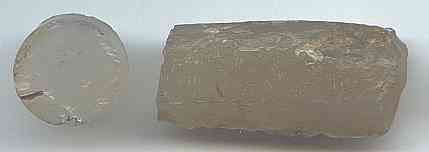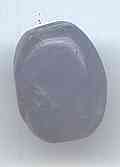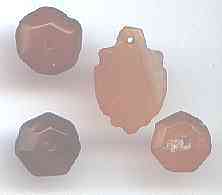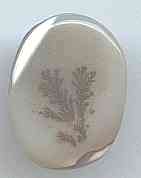 |
The Bead Site =Home>Beadmaking & Materials>Stones > Chalcedony
The Chalcedony (Agate) Family
|

|
|
Chalcedony (kal SED en ee) is a member of the quartz family of minerals.
It has microscopic crystals arranged in a fibrous pattern. It is named after Calcedon (KAL se don), an ancient city (now called Kadeköy, a suburb of Istanbul).
Above: blanks from the medieval beadmaking site of Limudra, India.
|
|
When used by itself, the word usually refers to a grayish, whitish, or brownish stone. Much rarer is a blue variety.
The term is also used for all fibrous microcrystalline quartz minerals.
|

|
|

|
When chalcedony is red (the stone usually has to be heated to bring out the color), it is called carnelian, the most popular single bead gemstone. Carnelian ranges in color from a dark brown (also known as sard), to a red, an orange, and even a yellow shade.
Carnelian gets its name from cornel, a type of tree with red berries (e.g. Dogwood). The British spelling is cornelain, but leading British bead researchers and mineralogists use the carnelian variant.
|
|
Agate is distinguished from chalcedony by being figured in some way, banding being the most common.
As with chalcedony, its name apparently has a geographical origin. The Greek Theophrastus says it was named for the river Achates (now called the Drillo) in Sicily.
|

|
|

|
There are several hundred recognized agate varieties (and quite a few not officially sanctioned).
This one is called moss agate. It does not really enclose moss, but a mineral formation that resembles the plant.
|
|
This is one of my favorite beads. It is shaped like a Muslim charm case (the perforation runs along the top). The beadmaker realized that he could cut the stone so that it would make a pattern of vertical lines framing horizontal ones.
|

|
|

|
Heavily banded agate is called onyx, named after the fingernail because of its banding. While there is some natural onyx, nearly all is artificially produced by soaking banded agate in sugar water or honey over a low heat. When the stone is heated the sugar caramelizes, making brown onyx.
|
|
Black onyx is a later development, requiring submerging the stone in sulfuric acid.
The word "onyx" has several other meanings, discussed here.
|

|
|

|
When the banding is red and white, the stone is called a sardonyx.
The Romans referred to the rich agate and carnelian mines of western India as the "Sardonyx Mountains."
|
|
But, the divisions are not always so simple.
For example, what is this bead? Is it an agate?
A sardonyx? The red probably came out when the stone was heated to make it easier to chip.
Probably a very old bead, bought in Afghanistan and donated by Louise Jones.
|

|
|
Further Reading:
Indian Agate Beads - The story of the western Indian agate bead industry.
South Indian Stone Beads - Until recently an undiscovered, but very important beadmaking center.
Asia's Maritime Bead Trade - Stone beads of India, Southeast Asia, and China and much more.
__________________________________________________
Small Bead Businesses | Beading & Beadwork | Ancient Beads | Trade Beads
Beadmaking & Materials | Bead Uses | Researching Beads | Beads and People
Center for Bead Research | Book Store | Free Store | Bead Bazaar
Shopping Mall | The Bead Auction | Galleries | People | Events
The Bead Site Home | Chat Line | Contact Us | Site Search Engine | FAQ
|
 |










